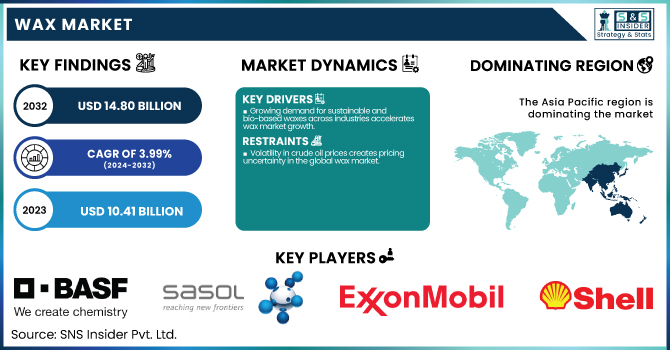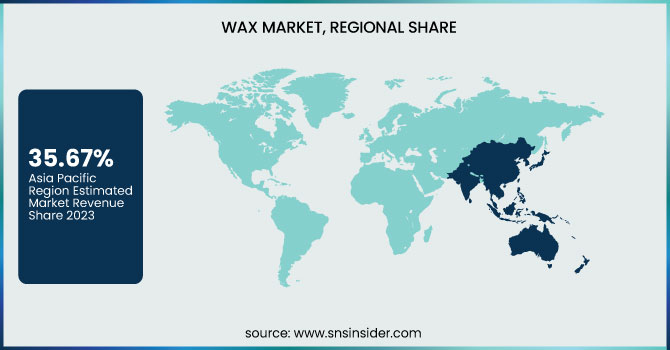Wax Market Report Scope & Overview:
The Wax Market size was USD 10.41 billion in 2023 and is expected to reach USD 14.80 billion by 2032 and grow at a CAGR of 3.99% over the forecast period of 2024-2032.

To Get more information on Wax Market - Request Free Sample Report
This report provides a comprehensive analysis of the pentaerythritol market, covering key production and utilization trends by country and type in 2023. It examines feedstock price fluctuations across regions and types, highlighting cost dynamics influencing market growth. The study evaluates the regulatory landscape, detailing country-specific policies and their impact on production and trade. Environmental metrics, including emissions data, waste management strategies, and sustainability initiatives, are analyzed by region to assess the market’s ecological footprint. Additionally, the report explores innovation and R&D advancements by type, emphasizing new product developments and technological progress shaping the industry. These insights offer a detailed view of market dynamics, regulatory shifts, and sustainability efforts, providing stakeholders with crucial data for strategic decision-making.
The United States held the largest market share in the wax market, valued at USD 2.23 billion in 2023, and is projected to reach USD 3.36 billion by 2032, growing at a CAGR of 4.65% from 2024 to 2032. This dominance is driven by the strong demand for wax in key industries such as packaging, cosmetics, pharmaceuticals, and automotive. The presence of major players, advanced refining technologies, and a well-established petrochemical industry contribute to the country’s leadership in wax production. Additionally, the rising adoption of bio-based and synthetic waxes due to increasing sustainability initiatives and regulatory policies is further boosting market growth. The growing use of wax in industrial coatings, adhesives, and 3D printing applications also supports market expansion, making the U.S. a key contributor to the global wax market.
Wax Market Dynamics
Drivers
-
Growing demand for sustainable and bio-based waxes across industries accelerates wax market growth.
The shift towards sustainability is driving demand for bio-based and synthetic waxes, particularly in industries such as cosmetics, packaging, and food. Consumers and regulatory bodies are pushing for eco-friendly alternatives to petroleum-based waxes, leading manufacturers to invest in plant-based and biodegradable waxes. In the cosmetics industry, natural waxes derived from soy, beeswax, and carnauba are replacing paraffin due to their non-toxic properties. Additionally, the packaging sector is witnessing an increase in wax coatings for food-grade applications, aligning with growing environmental concerns. Advancements in refining processes and the development of performance-enhancing additives are further expanding application areas. This trend is expected to accelerate the adoption of sustainable waxes, boosting overall market growth.
Restrain
-
Volatility in crude oil prices creates pricing uncertainty in the global wax market.
Since a significant portion of wax production is derived from crude oil refining, fluctuations in oil prices directly impact the wax market. The unpredictability in crude oil prices due to geopolitical tensions, supply-demand imbalances, and production regulations creates uncertainty for wax manufacturers and end-users. Price volatility affects procurement costs, leading to inconsistencies in product pricing across industries such as candles, coatings, and adhesives. Additionally, increasing regulatory restrictions on petroleum-based waxes are further pressuring manufacturers to shift toward alternatives, increasing production costs. This unpredictability often results in supply chain disruptions, compelling businesses to explore cost-effective substitutes like bio-based and synthetic waxes. However, the transition to alternative sources requires significant R&D investments, making price stability a critical concern for long-term market sustainability.
Opportunity
-
Growing applications of wax in 3d printing and industrial coatings create market expansion opportunities.
The rapid advancements in 3D printing technology and industrial coatings are driving new opportunities in the wax market. Wax-based materials are gaining traction in additive manufacturing due to their superior moldability, making them ideal for creating intricate prototypes and investment casting applications. Additionally, the coatings industry is increasingly utilizing wax additives to enhance durability, water resistance, and scratch protection in paints and surface finishes. The automotive and construction sectors are witnessing heightened demand for wax coatings to improve the longevity of surfaces exposed to harsh environmental conditions. Furthermore, ongoing R&D efforts are leading to the innovation of high-performance waxes tailored for advanced manufacturing processes. This growing demand across multiple industries is expected to open lucrative avenues for wax manufacturers and suppliers in the coming years.
Challenge
-
Challenges in developing cost-effective bio-based waxes to meet rising sustainability standards.
Despite the increasing demand for sustainable waxes, the high production cost of bio-based and synthetic alternatives remains a major challenge. Developing plant-based and biodegradable waxes requires extensive R&D investments, advanced processing technologies, and access to reliable raw material sources. The extraction and refinement processes for natural waxes such as soy, carnauba, and beeswax are more resource-intensive than traditional petroleum-based waxes, resulting in higher costs. Additionally, achieving the same performance characteristics as paraffin wax in applications such as candles, cosmetics, and coatings requires continuous innovation. Many industries are hesitant to switch due to cost concerns and performance uncertainties, slowing the adoption of eco-friendly alternatives. Overcoming these challenges will require technological advancements and economies of scale to make bio-based waxes commercially viable and competitive in the global market.
Wax Market Segmentation Analysis
By Product
Mineral wax held the largest market share, around 68.23%, in 2023. It is owing to its availability, cheapness, and adoption across various end-use industries. Mineral waxes like paraffin and microcrystalline waxes are primarily derived from petroleum refining and are commonly used for packaging, cosmetics, candles, adhesives, and industrial coating applications. Glycerol Mono Stearate (GMS) is a type of binding agent that possesses better moisture resistant quality, smooth surface, food-grade suitable, and most widely used in food-grade packaging and pharmaceuticals, which makes for an excellent binding agent. Moreover, the conventional refining network for petroleum-based waxes is not only extremely familiar but also readily available and cheaper than synthetic and bio-based substitutes. One of the major users of wax is the candle industry, which relies extensively on paraffin wax because of its combustion performance and price. Mineral wax is estimated to account for the highest market share owing to its wide range of applications in industries across the globe and will remain the dominant product type despite growing concerns for sustainability.
By Application
Candle held the largest market share, around 35%, in 2023. It is increasing consumer demand for decorative, scented, and therapeutic candles in residential and commercial sectors. The growing consumer attention towards aromatherapy and wellness trends has provided a significant thrust to the sales of scented candles containing essential oils, especially across North America and Europe. Besides, candles are also used as religious, cultural, and home ornaments and, thus, contribute to constant sales. The transition to green and natural wax candles, soy and beeswax candles, in particular, are gaining market share as greener alternatives to paraffin wax, is another factor, driving demand. Additionally, large retail chains and e-commerce sites have introduced new lines of candle products, making them accessible to many more. The chorus of aesthetic appeal, therapeutic benefits, and changing consumer trends has carved out candles as the stoutest application segment in the global wax market.
Wax Market Regional Outlook
Asia Pacific held the largest market share, around 35.67%, in 2023. Rapid industrial sector, high consumer demand, and high availability of raw materials were the factors responsible for the wax market growth in this region. China, India, and Japan are also significant producers and consumers of wax owing to considerable growth in applications such as candles, packaging, cosmetics, and rubber processing. Disposable income levels and urbanization in most emerging economies have remained high, which has contributed to an increase in demand for luxury and personal care products, thereby driving wax usage in cosmetic and skincare formulations. Moreover, the region has an established petrochemical industry that provides a constant supply of paraffin wax, which is a key market driver. This has further bolstered the market growth through government initiatives for bio-based wax production and sustainable alternatives. Asia Pacific continues to dominate the global wax market due to an established industrial sector and favorable economic developments resulting in changing consumption patterns along with industrial applications.
North America held a significant market share. There is a high demand for premium-grade wax-containing products and technological advancements in the area of sustainable wax alternatives. Major producers involved in the manufacturing of paraffin, synthetic and natural waxes for various applications such as packaging, personal care and automotive industries, are primarily located in the region, especially in the U.S. and Canada. The rising demand for luxury candles, organic cosmetics, and sustainable packaging materials used in the packages is continuing to push up the demand. Moreover, technological innovations in the production of bio-based and synthetic waxes and higher environmental regulations have promoted innovations and sustainable product developments. Market growth is driven by the increasing disposable income of people in the region and the adoption of premium quality wax-based skincare and haircare products. North America continues to be one of largest regions in global wax market with continued research and development activities.

Get Customized Report as per Your Business Requirement - Enquiry Now
Key Players
-
BASF SE (Cera Performance, Luwax)
-
Sasol Limited (Sasolwax, Paraffin Wax)
-
ExxonMobil Corporation (Parvan, Mobilwax)
-
Royal Dutch Shell Plc (Shell GTL Sarawax, Shell Gas-to-Liquids Wax)
-
The Lubrizol Corporation (TempRite, Lubrizol Wax)
-
Evonik Industries AG (Vestowax, TEGO Glide)
-
Honeywell International Inc. (ACwax, Honeywell Micronized Wax)
-
Clariant AG (Licowax, Ceridust)
-
Trecora Resources (Petrolatum Wax, Specialty Waxes)
-
Michelman, Inc. (Michem Wax, Hydrosize)
-
Koster Keunen, Inc. (Beeswax, Sunflower Wax)
-
IGI Wax (IGI Paraffin Wax, Microcrystalline Wax)
-
Paramelt B.V. (Paraflex, Aquacer)
-
Strahl & Pitsch, Inc. (Refined Beeswax, Candelilla Wax)
-
HollyFrontier Corporation (Petrolatum, Microcrystalline Wax)
-
Fischer-Tropsch Wax Corporation (FT Wax, Synthetic Wax)
-
Nippon Seiro Co., Ltd. (Hi-Mic, Ozokerite Wax)
-
Sonneborn LLC (Multiwax, SonneNatural)
-
Goyel Chemical Corporation (Polyethylene Wax, Carnauba Wax)
-
Alpha Wax (Alpha FT Wax, HydroWax)
Recent Development:
-
In April 2024, BASF presented cutting-edge solutions at in-cosmetics Global in Paris, emphasizing the advancement of sustainability in the personal care industry.
-
In April 2024, ExxonMobil introduced Prowaxx, a new product brand for its waxes, establishing a scalable naming system for future wax offerings.
-
In September 2024, Evonik Industries AG opened a new production facility for sustainable emollients at its Steinau site, enhancing its capacity to meet the rising demand for eco-friendly cosmetic ingredients.
| Report Attributes | Details |
|---|---|
| Market Size in 2023 | USD 10.41 Billion |
| Market Size by 2032 | USD 14.80 Billion |
| CAGR | CAGR of 3.99% From 2024 to 2032 |
| Base Year | 2023 |
| Forecast Period | 2024-2032 |
| Historical Data | 2020-2022 |
| Report Scope & Coverage | Market Size, Segments Analysis, Competitive Landscape, Regional Analysis, DROC & SWOT Analysis, Forecast Outlook |
| Key Segments | •By Product (Mono-Wax, Di-Wax, Tri-Wax) •By Application (Paints & Coatings, Lubricants, Plasticizer, Explosives, Agriculture, Others) |
| Regional Analysis/Coverage | North America (US, Canada, Mexico), Europe (Eastern Europe [Poland, Romania, Hungary, Turkey, Rest of Eastern Europe] Western Europe] Germany, France, UK, Italy, Spain, Netherlands, Switzerland, Austria, Rest of Western Europe]), Asia Pacific (China, India, Japan, South Korea, Vietnam, Singapore, Australia, Rest of Asia Pacific), Middle East & Africa (Middle East [UAE, Egypt, Saudi Arabia, Qatar, Rest of Middle East], Africa [Nigeria, South Africa, Rest of Africa], Latin America (Brazil, Argentina, Colombia, Rest of Latin America) |
| Company Profiles | BASF SE, Sasol Limited, ExxonMobil Corporation, Royal Dutch Shell Plc, The Lubrizol Corporation, Evonik Industries AG, Honeywell International Inc., Clariant AG, Trecora Resources, Michelman, Inc., Koster Keunen, Inc., IGI Wax, Paramelt B.V., Strahl & Pitsch, Inc., HollyFrontier Corporation, Fischer-Tropsch Wax Corporation, Nippon Seiro Co., Ltd., Sonneborn LLC, Goyel Chemical Corporation, Alpha Wax. |

